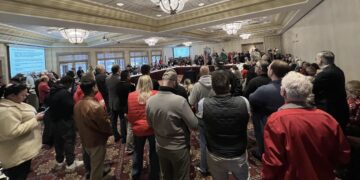By John F. Di Leo, Opinion Contributor
The nation suffered under the Biden-Harris regime. Even their acolytes, the hyper-partisan leftists who sing their praises and would never willingly admit that anything was the Biden-Harris regime’s fault, must admit (without assigning blame) that those four years were a nightmare for affordability.
Inflation skyrocketed. Whether one dined in or out, whether one rented or owned, whether one drove a car or minivan, everything cost more, month after month, year after year.
President Trump, in running for reelection, committed to bring down inflation right away, and his team has kept that promise; inflation in 2025 is a mere fraction of what it was before. Inflation – the rate of growth in the cost of living, year over year – has plummeted from about ten percent to less than two.
This is wonderful. A rate of inflation this low should enable people to get ahead of their bills, to start saving for the future, to stop living paycheck to paycheck.
The problem is, no matter how stable it is going forward, we still have the past four years to deal with. With prices having grown by leaps and bounds for four years, merely halting that growth isn’t enough for most people to recover. These four years of inflation have permanently devalued our homes, our 401Ks and other investments.
What we need is an actual retreat in prices.
This retreat is happening in some areas; gasoline has dropped from its highs; most groceries have dropped a bit from their 2024 peaks. But things aren’t back where they were four years ago, or even where they would have been after four years of mild inflation.
The prices that every American family confronts every day have found a new level, and while President Trump and his cabinet have implemented policies that have vastly improved things, they cannot completely turn back the clock.
Here are just a few of the many reasons why.
Salaries
If employers’ costs (purchased materials for manufacturing, and transportation and warehousing costs) go up temporarily, employers can weather the storm until the spike ends and those costs go back down. Employers may give their employees bonuses to help them weather the storm too, and to keep them from looking elsewhere, but they don’t have to increase employee salaries permanently.
On the other hand, if employers do choose to deal with temporary inflation by giving large permanent raises to their staff, or worse, if they are forced to by their unions, then the companies have irrevocably, permanently increased their cost of doing business; if they had instituted temporary price increases on their own goods, those price increases now have to be permanent, to keep on paying those higher payroll costs. And now, rather than being just a victim of the inflation problem, the company becomes one of its causes.
Transportation
During the Biden-Harris years, the bureaucracy waged an all-out assault on energy costs and the transportation industry. Changes in Hours of Service regulations and log book enforcement, banning normal trucks and trying to mandate costly and inefficient electric trucks instead, an outright war on owner-operators in California, and meddling with the oil drilling industry to increase the price of diesel – all these separate assaults raised the general cost of transportation and drove lots of trucking companies out of business.
As the Trump administration tackles each of these problems, one by one, the pressure eases somewhat, but with all of them happening at once, countless trucking companies had to raise salaries and hiring bonuses to keep employees, permanently raising the cost of transportation on the rest of the economy, from wholesale to retail, from manufacturing to distribution.
The personal transportation scene is no better:
Throughout both the Obama-Biden years and the Biden-Harris years, their assault on the auto industry resulted in redirecting all resources toward the electric vehicle market that only occupies a tiny niche share in the buying public. Now that the auto industry understands that it’s okay to build gasoline vehicles again, they must retool again, twice in a decade, and again redirect their design and manufacturing to succeed.
That’s a lot of pain for the economy to absorb. We will recover from it, but it will take years, and in the meantime, personal vehicles – from sedans to SUVs, from pickups to minivans, will continue to be historically overpriced and frankly out-of-reach for a large segment of the population.
The Printing Press
Every administration spends too much. Republican and Democrat, Executive and Legislative, they all overspend. But the Biden-Harris years broke all records.
It’s not just the checks they sent to individual citizens under the name of “stimulus.” It’s also the federal money, often cleverly buried in state and city appropriations, to give free room and board to illegal aliens, to fund welfare benefit advisors, to give cellphones, food stamps and other gifts to millions upon millions of people. It’s also the incredibly generous gifts, grants, and loans that various departments doled out, right up to the final hours, a billion to this EV manufacturer, a billion to that inefficient wind farm operator, a billion to yet another green scam machine…
Especially when a government is already running a deficit, such expenditures are obviously inflationary, as the creation of more unbacked cash means the devaluation of all the cash in the economy.
And even though President Trump’s team has stopped much of this ongoing outlay, the massive weight of the past waste will be with us forever, because it was all done with borrowed money.
Even if we stop passing out billion-dollar grants like candy (as Jennifer Granholm and Michael Regan prided themselves in doing for four straight years), we will still be paying the interest on those gifts for a century after the boondoggles they funded are forgotten.
Spending money you don’t have is always destructive; spending money you don’t have in an environment of insurmountable national debt and unnecessarily high interest rates is lethal.
So How Do We Recover?
There is a solution, however distant it may appear today.
Inflation has been conquered, and faster than most pundits expected, though it has left prices at an unforgivably higher baseline then they should be, and for this sin the Biden-Harris crowd – and their party – must be forever scorned. But the ongoing growth of prices, at least, has been arrested. That’s a start.
The solution is twofold – both every individual, and the economy as a whole, also – need to grow ourselves out of this debt.
We must think of the value of money.
Money only has a value in relation to the person who possesses, spends, or needs it. Consider a $30 entree at a restaurant: even though the restaurant will charge every patron the same amount – $30 – for the same entree, so everyone’s $30 is the same from the perspective of the restaurant, it’s different from the perspective of each diner. That $30 price has a different meaning to everyone in the place. For people earning $7.50/hour, $30 is four hours of work. For some, a bit more advanced in their careers, $30 represents one hour of work. And for the more successful, $30 is just ten minutes of work.
We must view the economy that way when looking at the colossal debt load that past administrations have stuck us with, and we must ask the question, how can we grow the economy so that our $37 trillion hard national debt (and our $106 trillion-plus real debt, when including unfunded mandates) represent an ever-shrinking amount in our total financial picture?
This is what the Trump Administration is driving toward in 2025: a reduction of dependence on foreign goods, a reduction of the dead weight of the illegal alien crisis, and an increase in domestic manufacturing, with all the job and wealth creation that will come with a manufacturing boom.
The solution to the pain of high-priced goods isn’t necessarily lowering the price printed on a price tag; it’s lowering the cost of that price relative to the buyer’s income.
America is finally embracing policies that create not just checks but jobs… not just jobs but careers… not just careers, but paths to the American Dream.
President Trump’s second term is off to a great start, but that team has so much more still to do, to put the United States on the way to again being the economic powerhouse it ought to be.
And fortunately, we’re only one-eighth of the way into the term; there’s plenty of time for more.
With the blessing of Divine Providence, America is Back.
Copyright 2025 John F. Di Leo
By Illinois ReviewMinnesota’s largest social services fraud cases centered on programs designed to protect the state’s most vulnerable populations – hungry children, children with disabilities, and adults struggling...
Read moreDetails








